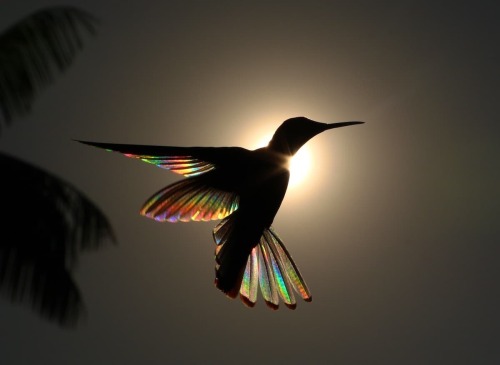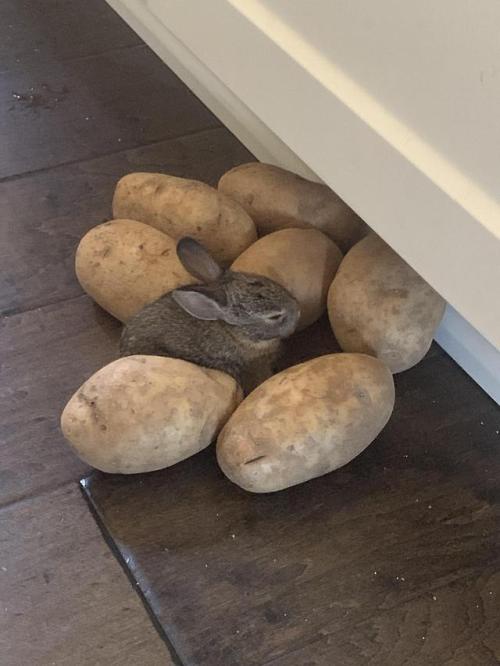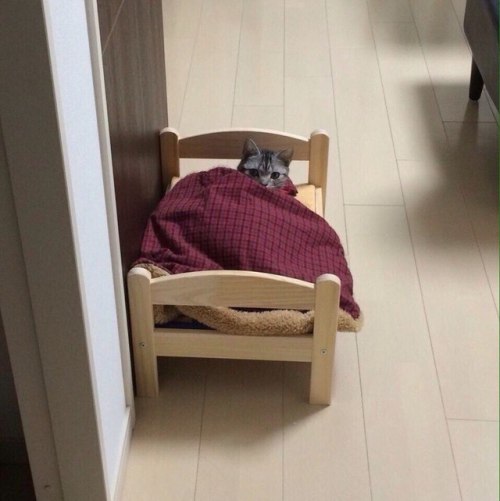A Rainbow Of Light Diffracts Through Hummingbird Wings In Photographs By Christian Spencer



A Rainbow of Light Diffracts Through Hummingbird Wings in Photographs by Christian Spencer
More Posts from Rocks-everywhere and Others


i found a book about cats from 1873 and i’m absolutely losing my mind
The end-cretaceous extinction is actually very simple. The asteroid caused all the dinosaurs to bounce up into the air like a trampoline, and only birds, who could fly, could survive falling from such a height





Blue tit/blåmes.


Let him wander around the house. Thought I lost him but he was next to the potatoes
How is Biotechnology Preparing us to Live on the Moon and Mars?
The adventures awaiting astronauts on future long-duration missions have technologists researching sustainable ways to live away from Earth. We’re using what we know from almost 20 years of a continuous human presence on the International Space Station and looking at new technologies to prepare for extended stays on the Moon and Mars.

Biotechnology – technology that uses living organisms to make products that provide a new use – is key to this research.
With biotechnology, we’re developing new ways to manufacture medicines, build habitats and more in space. Here are some ways biotechnology is advancing spaceflight and how the same research is reaping benefits on Earth.

Healthy astronauts
Planning ways to supply food for a multi-year mission on the Moon or Mars may require making food and nutrients in space. Our scientists are testing an early version of a potential solution: get microorganisms to produce vital nutrients like those usually found in vegetables. Then, whenever they’re needed, astronauts can drink them down.
The microorganisms are genetically engineered to rapidly produce controlled quantities of essential nutrients. Because the microorganisms and their food source both have a long shelf-life at room temperature and only need water to be activated, the system provides a simple, practical way to produce essential nutrients on-demand. The same kind of system designed for space could also help provide nutrition for people in remote areas of our planet.
Our researchers are evaluating the first batches of BioNutrient samples that came back to Earth after an experimental run on the International Space Station.

Because space travel takes a toll on the human body, we’re also researching how biotechnology can be used to advance the field of regenerative medicine.
Related cells that are joined together are collectively referred to as tissue, and these cells work together as organs to accomplish specific functions in the human body. Blood vessels around the cells vascularize, providing nutrients to the tissue to keep it healthy.
Our Vascular Tissue Challenge offers a $500,000 prize to be divided among the first three teams that successfully create thick, metabolically-functional human vascularized organ tissue in a controlled laboratory environment. The vascularized, thick-tissue models resulting from this challenge will function as organ analogs, or models, that can be used to study deep space environmental effects, such as radiation, and to develop strategies to minimize the damage to healthy cells.
Plant factories
Humans have relied on plants’ medicinal qualities for thousands of years for everything from alleviating minor ailments to curing serious diseases. Now, researchers are trying to simplify the process of turning plants into medicine (i.e. how to make it compact and portable). If successful, the cost of biomanufacturing pharmaceuticals on Earth could go down, and plants could produce medicines in space.

Creating medicine on demand isn’t something we typically do, so we’re turning to experts in the field for help. Researchers at the University of California, Davis are transforming plants into mini-medicine factories for future Mars missions. They’re genetically altering an ordinary type of lettuce so that it produces a protein called parathyroid hormone. This hormone is an approved drug for treating osteoporosis, a common condition where bones become weak and brittle.

This type of research is vital to long duration spaceflight. When astronauts land on Mars, they’ll need to be strong—ready to explore. The length of the flight in zero gravity to get there and lower gravity on the surface could have a negative impact on human bones. Having the technologies needed to treat that possibility, and other unanticipated health effects of long duration spaceflight, is crucial.
Growing habitats
Vitamins aren’t the only thing astronauts could be growing on Mars; we’re exploring technologies that could grow structures out of fungi.
An early-stage research project underway at our Ames Research Center is prototyping technologies that could “grow” habitats on the Moon, Mars and beyond out of life – specifically, fungi and the unseen underground threads that make up the main part of the fungus. These tiny threads build complex structures with extreme precision, networking out into larger structures like mushrooms. With the right conditions, they can be coaxed into making new structures – ranging from a material similar to leather to the building blocks for a planetary home.
The myco-architecture project envisions a future where astronauts can construct a habitat out of the lightweight fungi material. Upon arrival, by unfolding a basic structure made up of dormant fungi and simply adding water, the fungi would grow around that framework into a fully functional human habitat – all while being safely contained to avoid contaminating the external environment.

Recycling waste
Once astronauts arrive on the surface of the Moon or a more distant planet, they’ll have to carefully manage garbage. This waste includes some stuff that gets flushed on Earth.
Today, we’re already using a recycling system on the space station to turn urine into drinking water. Poop on the other hand is contained then disposed of on spacecraft returning to Earth. That won’t be possible on more distant journeys, so, we’re turning to biomanufacturing for a practical solution.
Biology can serve as an effective recycling factory. Microorganisms such as yeast and algae feed on all kinds of things classified as “mission waste.” Processing their preferred form of nourishment generates products that can serve as raw materials used to make essential supplies like nutrients, medicines, plastic and fuel.

By taking a careful look at biological processes, we hope to develop new, lightweight systems to leverage that biology to do some helpful in-space manufacturing.
From Space to Earth
Biotechnology is preparing us for longer space missions to the Moon and then Mars – farther from Earth than humans have ever traveled before. As we prepare for those exciting missions, we’re also conducting research on the space station for the primary benefit of everyone on Earth.
January is National Biotechnology Month. To learn more about some of the ways NASA is using biotechnology to solve challenges in space and improve life on Earth, visit this link.
Make sure to follow us on Tumblr for your regular dose of space: http://nasa.tumblr.com


Rime-rimmed rocks
Looking a bit like white moss, these cairn stones on Mountbenger Law in Scotland (at an elevation of 543 m) are covered in a special type of ice known as rime.
Keep reading
Me writing: “She knew she had to go in this town called…”
My brain:





Cat located
-
 starryrika liked this · 1 month ago
starryrika liked this · 1 month ago -
 almostangrything reblogged this · 1 month ago
almostangrything reblogged this · 1 month ago -
 almostangrything liked this · 1 month ago
almostangrything liked this · 1 month ago -
 ford-pinto liked this · 2 months ago
ford-pinto liked this · 2 months ago -
 qreyjoytheon reblogged this · 2 months ago
qreyjoytheon reblogged this · 2 months ago -
 starfleetsacademy reblogged this · 2 months ago
starfleetsacademy reblogged this · 2 months ago -
 dream-in-shadow liked this · 3 months ago
dream-in-shadow liked this · 3 months ago -
 idontknow13538 liked this · 3 months ago
idontknow13538 liked this · 3 months ago -
 halfpoisonhalfgod liked this · 3 months ago
halfpoisonhalfgod liked this · 3 months ago -
 merridelicious reblogged this · 3 months ago
merridelicious reblogged this · 3 months ago -
 merridelicious liked this · 3 months ago
merridelicious liked this · 3 months ago -
 rat-experiencing-midlife-crisis reblogged this · 4 months ago
rat-experiencing-midlife-crisis reblogged this · 4 months ago -
 multicolored-world reblogged this · 5 months ago
multicolored-world reblogged this · 5 months ago -
 fadeint0 reblogged this · 5 months ago
fadeint0 reblogged this · 5 months ago -
 xstar-crossedx reblogged this · 5 months ago
xstar-crossedx reblogged this · 5 months ago -
 danane-banane reblogged this · 7 months ago
danane-banane reblogged this · 7 months ago -
 inthecleaningcart22 liked this · 7 months ago
inthecleaningcart22 liked this · 7 months ago -
 hotrod6950 liked this · 7 months ago
hotrod6950 liked this · 7 months ago -
 past4-any0ne reblogged this · 7 months ago
past4-any0ne reblogged this · 7 months ago -
 past4-any0ne liked this · 7 months ago
past4-any0ne liked this · 7 months ago -
 cracklinhaze liked this · 7 months ago
cracklinhaze liked this · 7 months ago -
 gaiawatcher liked this · 7 months ago
gaiawatcher liked this · 7 months ago -
 drgoosedmd-blog liked this · 7 months ago
drgoosedmd-blog liked this · 7 months ago -
 wait-whats-happening reblogged this · 7 months ago
wait-whats-happening reblogged this · 7 months ago -
 wait-whats-happening liked this · 7 months ago
wait-whats-happening liked this · 7 months ago -
 itsssoromantic reblogged this · 7 months ago
itsssoromantic reblogged this · 7 months ago -
 itsssoromantic liked this · 7 months ago
itsssoromantic liked this · 7 months ago -
 qrfit reblogged this · 7 months ago
qrfit reblogged this · 7 months ago -
 qrfit liked this · 7 months ago
qrfit liked this · 7 months ago -
 sleeping-arsonist liked this · 7 months ago
sleeping-arsonist liked this · 7 months ago -
 caught-in-annette liked this · 7 months ago
caught-in-annette liked this · 7 months ago -
 beccsssssss reblogged this · 7 months ago
beccsssssss reblogged this · 7 months ago -
 beccsssssss liked this · 7 months ago
beccsssssss liked this · 7 months ago -
 melthemoon reblogged this · 7 months ago
melthemoon reblogged this · 7 months ago -
 melthemoon liked this · 7 months ago
melthemoon liked this · 7 months ago -
 your-tiny-love liked this · 7 months ago
your-tiny-love liked this · 7 months ago -
 redglittercoffin liked this · 7 months ago
redglittercoffin liked this · 7 months ago -
 redglittercoffin reblogged this · 7 months ago
redglittercoffin reblogged this · 7 months ago -
 notations reblogged this · 7 months ago
notations reblogged this · 7 months ago -
 notations liked this · 7 months ago
notations liked this · 7 months ago -
 juliamccartney reblogged this · 7 months ago
juliamccartney reblogged this · 7 months ago -
 letargia liked this · 7 months ago
letargia liked this · 7 months ago -
 murobrown reblogged this · 7 months ago
murobrown reblogged this · 7 months ago -
 murobrown liked this · 7 months ago
murobrown liked this · 7 months ago -
 twosilvercandlesticks liked this · 8 months ago
twosilvercandlesticks liked this · 8 months ago -
 channel-37 reblogged this · 11 months ago
channel-37 reblogged this · 11 months ago
225 posts